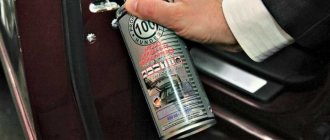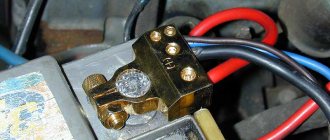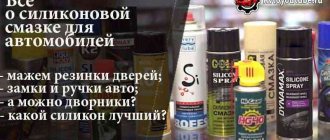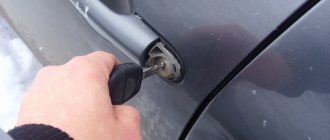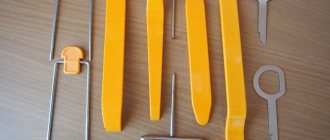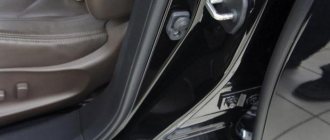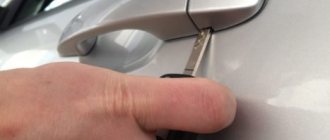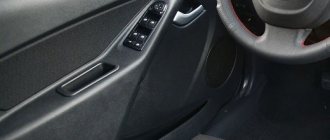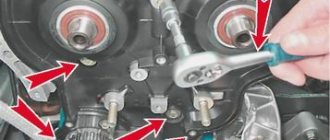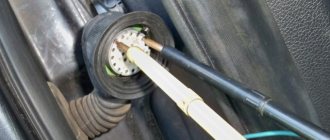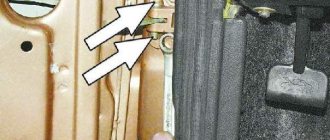The problem of creaking hinges in car doors is quite relevant among car owners. The reason for its appearance is dry friction of surfaces due to insufficient lubrication of the mechanism.
It is quite natural that the factory lubricant, under conditions of constant opening of doors and exposure to aggressive environments, is used, washed off or dries out.
It would seem that solving this problem is simple, but not all drivers know how to lubricate car door hinges and what needs to be taken into account when selecting a material. Let's figure it out.
Why do hinges begin to creak?
Creaking door sounds occur for several reasons, and they often appear in cars with a short service life:
- multiple opening/closing;
- unfavorable weather conditions;
- wear of the rubber bands responsible for the tight fit of the door to the body;
- poor-quality factory lubricant;
- door sagging;
- poor quality assembly of components, which is especially noticeable in domestic cars;
- very frequent washing of the car, because water, coupled with chemicals, washes out the lubricant;
- washing the car too rarely, as a result of which the lubricant becomes clogged with dirt.
However, even with systematic care of a good quality car, there is a possibility of door squeaks.
How to remove squeaks from inside a car
Nowadays, creative drivers manage to lubricate everything they can get their hands on, from vinegar and kerosene to iodine. But it is still better to use professional recommended methods to eliminate this problem.
It is worth purchasing a special lubricant for car door hinges and seals. They come in a variety of varieties and are sold in specialized auto stores. The property of a lubricant is to penetrate deeply into the gaps of parts rubbing against each other.
Lubricants for car door hinges
Stores offer a wide selection of lubricants with different characteristics - it all depends on the preferences of the car owner. A lubricant for car door hinges is in demand among car enthusiasts; it prevents the formation of a corrosive coating for a long time - when applied, it creates a water-repellent layer on the hinge. Other compositions have high penetrating qualities, while others relieve working units from loads - dynamic and static.
Which lubricant to choose for car door hinges
Car doors should be lubricated with consistency compounds that have good penetration into the gaps and create a moisture-reflecting coating on the surface of the components. The material must:
- have excellent anti-corrosion qualities;
- minimize friction of elements;
- be resistant to temperature fluctuations;
- have a long service life;
- reduce friction of mating surfaces.
Choose a composition with little fluidity - too liquid ones will instantly lose their functions. If the store does not have a full-fledged lubricant, you can temporarily replace it with a grease material. Such compositions have good permeability and quickly neutralize annoying squeaking. Motor oil or lithol is also used. However, the oil evaporates quickly, and lithol is incredibly sticky, so it instantly attracts particles of debris.
Common lubricants
Lubricants for coating hinges in cars are divided into 2 groups - polymer and mineral.
Polymer
Polymer compositions are made on a silicone base. The lubricant is able to withstand severe temperature changes and other loads without loss of properties. Polymer lubricant is produced in tubes and in spray form. When working with paste from a tube, it is necessary to protect the skin of your hands with gloves. Spray lubricant is more convenient to use, as it allows you to reach hard-to-reach places.
Attention! Another type of polymer lubricant is technical petroleum jelly, but it is rarely used due to the poor quality of the product.
Mineral
Unlike polymer analogs, mineral coatings are more durable due to their consistency. In winter, they perfectly protect the door mechanism from moisture. One of the popular types of mineral lubricant includes lithium - it creates a strong barrier to moisture and reduces friction of door parts. Perhaps the only drawback of the product is poor protection of the hinges from corrosion. Places where the lubricant is applied in a thin layer succumb to rust faster.
What happens if you don't lubricate squeaking doors?
Creaking doors indicate a problem. The problem is the lack of an oil film between the rubbing surfaces of the door hinges. If there is no oil gasket, then metal rubs against metal and begins to “eat” itself. Usually one hinge wears out faster and one day the door will warp and you won't be able to close it. In addition, the friction point will become covered with rust and begin to rapidly deteriorate. In particularly advanced cases, the door may simply fall off.
Effective lubricants
After reading the top five, you will learn how to lubricate a car door to prevent squeaking:
- Liqui Moly Wartungs Spray Weiss.
- Wurth HHS 2000.
- CRC-MULTILUBE.
- Permatex 80075.
- Klever Ballistol-Silicon Spray.
Liqui Moly Wartungs
Liqui Moly is a common whitish-colored product containing microceramics. It has anti-corrosion and moisture-repellent characteristics, prevents the penetration of dirt particles into the door mechanism for a long time and reduces friction of structural parts.
Liqui Moly Wartungs Spray Weiss is a specialized product designed for processing movable parts, keyholes, hinges, rods, etc. The product is based on mineral oil. Temperature range of application - from -30° C to +250° C.
Advice! The Liqui Moly Wartungs composition can be used to coat not only hinges, but also all kinds of moving parts of a car.
Wurth HHS 2000
Wurth HHS 2000 lubricant is a product of German manufacturers that has won the special love of car enthusiasts. Car owners liked the lubricant due to its rapid thickening, excellent adhesive and penetrating properties, and good stickiness. Ideal for application to door hinges, locks, stops. The product is resistant to strong water pressure and prolongs the service life of mechanisms, even those operating under high pressure.
The main highlight of Wurth HHS 2000 is its rapid transformation from an aerosol to a thick lubricant. Thanks to this property, it reaches hard-to-reach places and remains there for a long time, protecting elements from moisture and reducing friction. The operating temperature range is from -30° C to +180° C. The main disadvantage is the adhesion of grains of sand, dust, and other debris. Plus - low cost.
CRC-MULTILUBE
A universal lubricating composition with high penetrating and water-repellent characteristics. Gets into the most difficult areas of mechanisms, creating a durable protective film. Thus, it significantly reduces the friction of the joints and prolongs their service life. Retains original lubricating properties even with sudden temperature changes.
Multilube has a distinctive feature - a bright blue color, which indicates areas not yet covered with the composition. Thanks to this, the car owner immediately sees where the lubricant is applied. A few days after processing the mechanisms, the product becomes discolored.
Permatex 80075
Permatex 80075 is a colorless lubricant that perfectly protects moving parts of door hinges from wear. Extends the service life of mechanisms and has high anti-corrosion properties. It is in a liquid state in the container, but at the moment of spraying it turns into foam. This allows the compound to reach hard-to-reach places, protecting hinge elements and keyholes from wear and squeaking.
Klever Ballistol-Silicon Spray
One of the materials used not only for processing metal parts, but also spare parts made of plastic, rubber and rubber. Provides a sliding effect of rubbing elements, significantly extending the service life of door “joints”. The spray contains silicone, which allows it to be used at any time of the year - both in cold and heat.
Attention! The universal fluid WD-40, known to most car enthusiasts, or simply “Vedeshka”, has excellent anti-corrosion properties, but quickly washes out the lubricant.
What is the best way to lubricate car door hinges?
To lubricate door hinges, it is better to choose compounds that meet the following criteria:
- prevention and destruction of rust;
- maintaining properties at very low or too high temperatures;
- maximum friction reduction;
- penetration into hard-to-reach places;
- long service period;
- low price with good quality.
It is important to buy products that have fluidity - otherwise, the interior and body of the car will be difficult to wash off stains. Many drivers like products based on molybdenum disulfide. This product is excellent for bearings, transmissions and engines, but you should not lubricate door “joints” with it - the product is easily soiled and attracts a lot of dirt.
General requirements
Without focusing on a specific manufacturer or type of lubricant, when choosing a suitable composition for locks and hinges, a number of requirements should be presented to the product. They are common to all, and consist in ensuring that the lubricant has:
- viscous structure;
- high strength;
- resistance to work at low and high temperatures;
- good lubricating properties;
- stability of physical and chemical properties;
- resistance to mechanical stress;
- wear resistance;
- water-repellent characteristics;
- anti-corrosion resistance.
If the lubricant you choose meets all these criteria, you won’t have to worry about locks and hinges. They will be under reliable protection. But it will have to be periodically monitored and the layer of lubricant renewed as it wears out and becomes thinner. Here are a few examples of what products can be used when processing door hinges and locks.
How to properly lubricate hinges
It is a misconception that to eliminate squeaking it is enough to spray the hinges on top with an aerosol or treat only the working parts. The effect will be, but short-lived, and soon the creaking sound will return.
- You must first remove any accumulated dirt from the hinges using a wide brush. It will not be possible to do this simply, since sand and dust particles are mixed with a lubricant - you will have to treat it with regular gasoline or white spirit.
- Remove gasoline residues with dirt, as well as traces of corrosion using a rust converter.
- Apply new compound to the hinges. The effect will be greater if the mechanism is not completely filled with the product, but only the surfaces of the mating areas are smeared. Wipe off excess product with a rag.
- Open and close the door 15-20 times to evenly distribute the lubricating components throughout the hinge. Also remove excess with a rag.
If after lubrication the doors continue to creak, there are a number of reasons for this:
- the lubricant was of poor quality/outdated;
- the doors sagged;
- old grease was poorly removed, leaving debris particles.
Important advice! It is best to process the loops after washing, in the autumn, when there is no longer any heat, but the cold has not yet set in.
How to lubricate step by step
Lubricating hinges was once a creative process that required experience and dexterity. This was due to the consistency and packaging of the lubricant, as well as the design of the hinges. Today, lubricant for cars is produced in cylinders with a proboscis nozzle. This allows you to “fill” the material pointwise and deep enough, rather than filling the entire surface. The hinges themselves have a movable rod, and it is enough to treat it with protection.
We recommend: How to make a soap-soda solution for household and medical needs
Instructions:
- Open the car door.
- Use a rag to remove any initial dirt from the hinge.
- Spray with a remover, such as WD-40, and remove any remaining dirt and old grease.
- If corrosion is visible on metal parts, use a rust converter. Remove any remaining oxide and apply anti-corrosion protection (the latter is not necessary if a high-quality lubricant with anti-corrosion protection is used).
- Having fitted the proboscis nozzle, distribute the lubricant onto the moving parts of the loop.
- Use a napkin to remove excess material and drips.
- Close and open the door several times (up to 25).
- Open and remove any excess that appears. Wipe the door, seal, body sill and part of the interior if grease gets there.
- Close the door.
Lubrication procedure
It is impossible to fully carry out the procedure for lubricating the door hinge without disassembling the mechanism. So, to process the parts you need:
- Arm yourself with an open-end wrench and unscrew the bolt securing the locks.
- Slide the door handle in the direction opposite to the door opening and remove it.
- If the handle does not come off, you should slightly rock it in different directions.
- Find a couple of levers inside the door and carefully apply lubricant to them.
- Also treat the inside of movable locking elements and handles. The locking mechanism can be reached by removing the protective plastic cover.
- Remove excess lubricant with a rag.
- Reinstall the lock and handle.
- Open and close the door several times, listening to see if the squeak remains.
In order not to constantly disassemble the locking mechanism, you can use an aerosol with a special tube. Insert one end of the tube into the lock, the other into the sprayer.
Another unpleasant moment characteristic of the winter-spring season is the freezing of the door along the contour of the seal. This often happens after washing the car or during a thaw, when the daytime temperature rises and drops sharply in the evening. In this case, there is a risk of tearing off the seals or not opening the car door at all. Silicone lubricant designed for rubber products can be a salvation.
An unpleasant squeak when opening/closing a car door can be prevented if you regularly, at least 1-2 times a year, apply a lubricant to the stops and hinges. This can be done using a 25 cc medical syringe.
Don’t be lazy - before winter, be sure to remove the locks and lubricate the door mechanisms from the inside. This way you will protect them from rapid wear and tear and save yourself from the unpleasant creaking sound.
Do not leave the car wash in cold weather without drying your car first. Spend 5-10 minutes drying, and to speed up the effect, open and close the doors several times in turn. Excess moisture will drain out on its own, and you will have peace of mind for your car.
